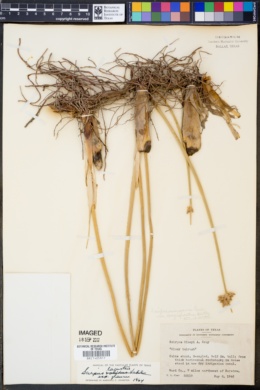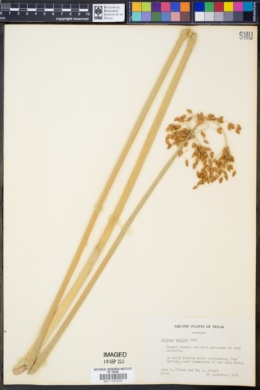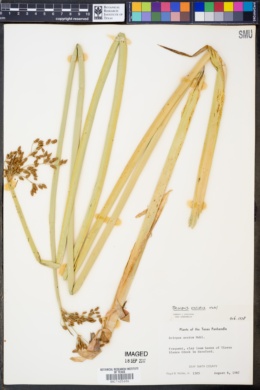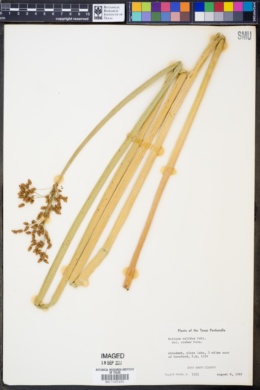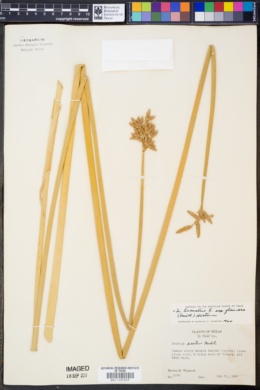|
|
|
|
Family: Cyperaceae
softstem bulrush, more...great bulrush, soft-stem bulrush
[Schoenoplectus lacustris ssp. creber (Fern.) A.& D. Löve, moreSchoenoplectus lacustris ssp. tabernaemontani (K. C. Gmel.) A.& D. Löve, Schoenoplectus lacustris ssp. validus (Vahl) T. Koyama, Schoenoplectus validus (Vahl) A.& D. Löve, Schoenoplectus validus ssp. creber (Fern.) A.& D. Löve, Schoenoplectus validus ssp. luxurians (Miq.) Soják, Scirpus lacustris ssp. creber (Fern.) T. Koyama, Scirpus lacustris ssp. glaucus (Reichenb.) Hartman, Scirpus lacustris ssp. tabernaemontani (K.C. Gmel.) Syme, Scirpus lacustris ssp. validus (Vahl) T. Koyama, Scirpus tabernaemontani K.C. Gmel., Scirpus validus Vahl, Scirpus validus var. creber Fern.] |
Rhizomes 3-10 mm diam. Culms cylindric, 0.5-3 m × 2-10 mm. Leaves 3-4, basal; sheath fronts membranous-translucent, often pinnate-fibrillose; blades 1-2, C-shaped to dorsiventrally flat in cross section, usually much shorter than sheath, distal blade 2-200 × 1-4 mm, margins often scabridulous. Inflorescences 2-4 times branched, branches to 15(-25) cm; proximal bract usually erect, thickly C-shaped to subterete, 1-8 cm, margins sometimes scabridulous. Spikelets 15-200, solitary or in clusters of 2-4(-7), commonly all solitary, 3-17 × 2.5-4 mm; scales uniformly dark to pale orange-brown, sometimes straw-colored, sometimes prominently lineolate-spotted, midrib often pale or green, ovate, 2-3.5 × 1.5-2 mm, sparsely (rarely densely) reddish or straw-colored, scabrous on awn and distal parts of midrib and sometimes flanks, margins ciliate, hairs contorted; flanks veinless, apex obtuse to rounded, notch 0.2-0.3 mm deep, awn straight or bent, 0.2-0.8 mm. Flowers: perianth bristles 6, brown, ± equaling achene, densely retrorsely spinulose; anthers 2 mm; styles 2-fid, sometimes 3-fid near spikelet apex. Achenes dark gray-brown when ripe, plano-convex, obovoid, 1.5-2.8 × 1.2-1.7 mm; beak 0.2-0.4 mm. 2n = 42. Fruiting late spring-summer, spring-winter (south). Fresh to brackish marshes, fens, bogs, lakes, stream banks and bars, pioneering in disturbed places, often emergent in water to 1 m; 0-2400 m; Alta., B.C., Man., Nfld. and Labr., N.W.T., N.S., Ont., P.E.I., Que., Sask., Yukon; Ala., Alaska, Ariz., Ark., Calif., Colo., Conn., Del., D.C., Fla., Ga., Idaho, Ill., Ind., Iowa, Kans., Ky., La., Maine, Md., Mass., Mich., Minn., Miss., Mo., Mont., Nebr., Nev., N.H., N.J., N.Mex., N.Y., N.C., N.Dak., Ohio, Okla., Oreg., Pa., R.I., S.C., S.Dak., Tenn., Tex., Utah, Vt., Va., Wash., W.Va., Wis., Wyo.; Mexico; West Indies; Central America; s South America; Eurasia; Africa; Pacific Islands; Australia; New Zealand. Two yellow-striped forms of Schoenoplectus tabernaemontani are grown as ornamentals. Schoenoplectus validus, described from the Caribbean, and S. tabernaemontani, described from Europe, are here treated as one variable, cosmopolitan species without infraspecific taxa, pending further studies (J. Browning et al. 1995b; S. G. Smith 1995). Most North American plants have spikelets with reddish papillae or prickles on the scales, whereas some plants of coastal and boreal North America closely resemble most plants of northwestern Europe and southern Africa in their densely reddish prickly-papillose scales and are similar to the type of Scirpus glaucus J. E. Smith. Schoenoplectus tabernaemontani, S. acutus, S. heterochaetus, S. lacustris, and S. triqueter belong to the very difficult S. lacustris complex. The entire complex except S. triqueter was treated as the single species Scirpus lacustris (T. Koyama 1962b). Many Old World authors treat Schoenoplectus tabernaemontani as S. lacustris var. tabernaemontani or subsp. glaucus. Much of the local infraspecific variation in the Schoenoplectus lacustris complex is probably because of hybridization. Some studies support the recognition of separate species in this group (J. Browning et al. 1995b). Hybrids in North America include S. acutus × S. tabernaemontani, widespread and common, especially in the east; S. acutus × S. heterochaetus = S. ×oblongus (T. Koyama) Soják, widespread but uncommon; S. heterochaetus × S. tabernaemontani = S. ×steinmetzii (Fernald) S. G. Smith, eastern and most uncommon; S. tabernaemontani × S. triqueter = S. ×kuekenthalianus (Junge) Kent, lower Columbia River in Oregon and probably Washington; and S. acutus var. occidentalis × S. californicus, local in California. Except for its trigonous culms, S. triqueter is very similar to the S. lacustris complex and freely hybridizes with S. tabernaemontani, both in North America and Europe.
|



























